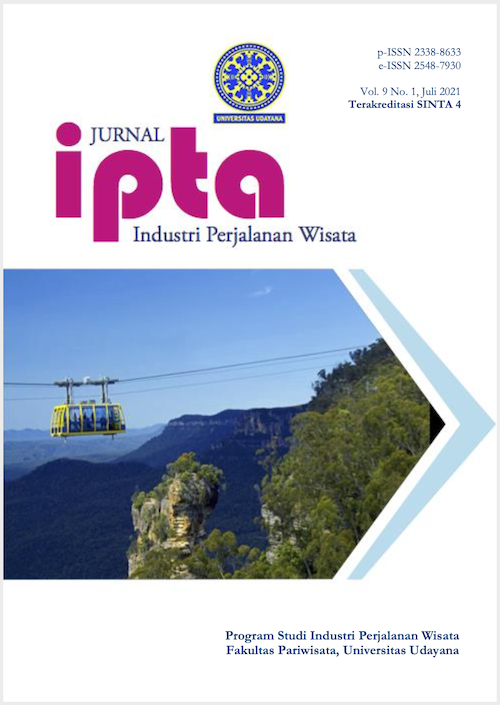PENGARUH ELECTRONIC WORD OF MOUTH TERHADAP KEPUTUSAN WISATAWAN MELAKUKAN AKTIVITAS DIVING PADA BLUE SEASON BALI
Abstract
In the era of Marketing 4.0, the rapid digitization has created a new face of competition reflected by shifting business practices, as well as consumer behavior from pre-purchase to post-purchase. Aside from companies that are constantly adaptive to technological advancements, consumers are becoming increasingly social and communal, so marketers need to understand new customer paths, and synergize online and offline interactions. This research aims to analyze the influence of electronic word of mouth towards tourist’s decision to do diving activities in Blue Season Bali. The technique of determining the sample used purposive sampling through distribution of questionnaires to 100 tourists who have experienced diving and accessed Blue Season Bali information on social media and website. This research applies data collection techniques which include: observation, interviews, questionnaires, literature study, and documentation. Multiple linear regression was used as an analytical technique to measure the influence of variable X on variable Y with SPSS software version 18. The research findings show that the intensity variable (X1) partially has no positive and significant effect on decision to do diving activities (Y) with sig. value 0,812>alpha 0,05. Valence of opinion variable (X2) partially has a positive and significant effect with sig. value 0,010<alpha 0,05. Content variable (X3) partially has a positive and significant effect with sig. value 0,000<alpha 0,05. Intensity, valence of opinion, and content simultaneously have a positive and significant effect with sig. value 0,000<alpha 0,05. The multiple linear regression test implies the results of regression equation, Y=13,580+(-0,046)X1+0,617X2+0,351X3+e, with coefficient of determination of 33%.
Downloads
References
Blazevic, V., Hammedi, W., Garnefeld, I., Rust, R.T., Keiningham, T., Andreassen, T. W., Carl, W. 2013. “Beyond traditional word-of-mouth an expanded model of customer-driven influence”, Journal of Service Management, Vol. XXIV, no. 3, pp. 294–313.
Cornell, J.A., Berger, R.D. 1987. “Factors that Influence the Value of the Coefficient of Determination in Simple Linear and Nonlinear Regression Models”, Article of The American Phytopathological Society, Vol. LXXVII, no. 1, pp. 63–69.
Databoks. (2018, July 23-last update). “4 Miliar Penduduk Bumi Telah Terkoneksi Internet”, available: https://databoks.katadata.co.id/datapublish/2018/07/23/4-miliar-penduduk-bumi-telah-terkoneksi-internet (accessed: 2019, August 29).
Goyette, et al. 2010. “E-Wom: Word of Mouth Measurement Scale for E-Service Context”, Journal of Administrative Sciences, Vol. XXVII, no. 1, pp. 5-23.
Greg. (2018, December 22-last update), “2018 Market Share of Scuba Certification Agencies (PADI, SSI, NAUI)”, available: http://www.divebuddy.com/blog/12618/2018-market-share-scuba-certification-agencies-padi-ssi-naui/ (Accessed: 2020, June 16).
Hennig- Thurau, Thorsten, Kevin P. Gwinner, Gianfranco Walsh, and Dwayne D. Gremler. 2004. “Electronic Word-of-Mouth via Consumer-Opinion Platforms: What Motivates Consumers to Articulate Themselves on the Internet?”, Journal of Interactive Marketing, Vol. XVIII, no. 1, pp. 38-52.
Johye, H., Jin-young, K. 2019. “Food tourists’ connectivity through the 5A journey and advocacy: comparison between generations Y and X”, Asia Pacific Journal of Tourism Research, Vol. XXV, no. 1, pp. 1-12.
Komalasari, Y., Sulastriningsih, D., Marjito. 2019. “Penerapan eWOM untuk Penentuan Keputusan Pembelian Barang Virtual Game Online (Studi Kasus: Wilayah Jawa Barat)”, Jurnal Computech dan Bisnis, Vol. XIII, no. 2, pp. 91-99.
Kotler, P., Kartajaya, H., Setiawan, I. 2017. Marketing 4.0: Moving from Traditional to Digital. New Jersey: John Wiley & Sons, Inc.
Kotler, P., Kartajaya, H., Huan H.D. 2017. Marketing for Competitiveness: Asia yang Mendunia pada Era Konsumen Digital. Yogyakarta: Bentang.
Kotler, P., Kartajaya, H., Setiawan, I. 2019. Marketing 4.0: Bergerak dari Tradisional ke Digital. Jakarta: Gramedia Pustaka Utama.
Nielsen. (2015, September 28-last update). “Global Trust in Advertising”, available: http://www.nielsen.com/us/en/insights/reports/2015/global-trust-in-advertising-2015.html (Accessed: 2020, March 8).
Nugraha, Angga. 2019. “Pengaruh e-WOM (Electronic-Word-of-Mouth) terhadap Keputusan Pembelian (Studi pada Instagram Kafe Kopine Eyang)”, Skripsi.
PADI. (n.d). “About PADI Dive Centers and Resorts”, available: https://www.padi.com/padi-dive-centers/business-levels (Accessed: 2020, June 22).
Parikh, A. A., Behnke, C., Nelson, D., Vorvoreanu, M., & Almanza, B. 2015. “A qualitative assessment of Yelp.Com users’ motivations to submit and read restaurant reviews”, Journal of Culinary Science & Technology, Vol. XIII, no. 1, pp. 1–18.
Poernamawati, Diana Eka. 2018. “Analisis Dimensi Electronic Word of Mouth (eWOM) dan Pengaruhnya terhadap Minat Kunjungan pada Obyek Wisata di Malang Raya”, Jurnal Administrasi dan Bisnis Vol. XII, no. 2, pp. 127-137.

This work is licensed under a Creative Commons Attribution-ShareAlike 4.0 International License.





